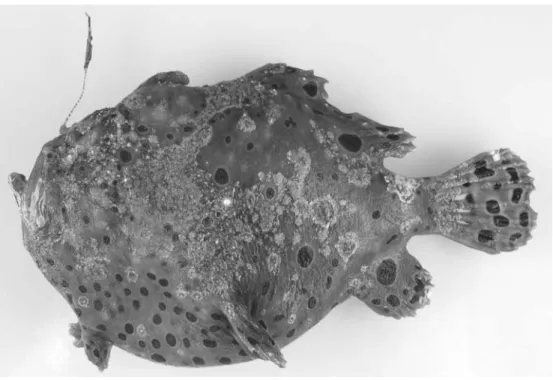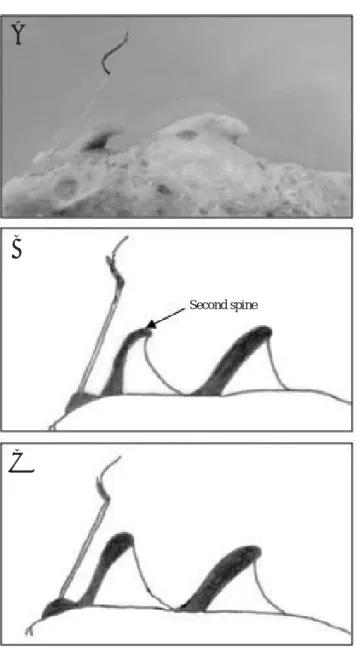—168—
INTRODUCTION
Antennariid fishes under the order Lophiiformes are known as the frogfishes and they are distributed in all tro- pical and subtropical seas except the Mediterranean Sea (Nelson, 2006). Among 42 species belonging to 12 gene- ra in the family Antennariidae reported worldwide (Nel- son, 2006), three frogfish species inhabit the coastal wa- ters of Korea thus far (Kim et al., 2005). They include Antennarius hispidus Bloch and Schneider, 1801; Anten- narius striatus Shaw, 1794; and Histrio histrio Linna- eus, 1758. Although Antennarius pictus was previously reported on basis of the underwater photograph (Yoo et al., 1995), it is difficult to confirm the correctness of spe- cies identification without counting or measuring the morphological characters of the actual specimen. Thus, this species has not been officially accepted to the list of Korean fish fauna up to date (Kim et al., 2005). In the present study, the morphological characteristics of A.
pictus were described based on the specimens in order to be added to the list of Korean fish fauna.
Counts and measurements of these specimens follow- ed the method of Hubbs and Lagler (1964). The examin- ed specimens were deposited at the Fish Genetics and Breeding Laboratory of Jeju National University (JNU), Korea.
Antennarius pictus (Shaw and Nodder, 1794) (New Korean name: Heuk-jum-bak-ssin-beng-i)
(Fig. 1; Table 1)
Lophius pictus Shaw in Shaw and Nodder, 1794: 176 (type locality: Tahiti, Society Islands).
Antennarius pictus: Pietsch, 1984: 34 (Indo-West Paci- fic); Pietsch, 1986: 368 (Indo-West Pacific); Allen and Swainston, 1988: 38 (north-western Australia), Goren and Dor, 1994: 14 (Red Sea); Randall, 1995: 84 (Oman);
Allen, 1997: 62 (Australia and south-east Asia); Myers, 1999: 69 (Micronesia); Randall and Lim, 2000: 597 (South China Sea); Senou, 2002: 457 (Japan); Allen and Adrim, 2003: 25 (Indonesia); Mundy, 2005: 264 (Hawaii).
Material examined. JNU20080603, 113.0 mm stan- dard length (SL), gill net, Daepo-ri, Seogwipo-si, Jeju- do, Korea, 3 June 2008. JNU20090826, 86.5 mm SL, bare hands, Sagye-ri, Andek-myen, Seogwipo-si, Jeju- do, Korea, 12 June 2009.
Description. Counts of present specimen shown in Table 1. Measurements as a percentage of SL are as fol- lows: Body depth 60.1~62.7; body width 21.9~25.1;
upper jaw 20.0~24.2; snout length 9.4~10.2; eye dia- meter 4.4~4.5; interorbital length 14.3~16.2; first pre- dorsal fin 2.5~5.0; second predorsal fin 6.9~8.8; third predorsal fin 18.5~26.1; prepectoral fin 52.4~52.5;
preanal fin 72.8~78.8; prepelvic fin 24.3~26.5; length of second dorsal spine 10.9~11.1; length of third dorsal spine 17.3~19.0; length of longest pectoral fin ray 19.0
~20.5 (4th ray); length of longest anal fin ray 13.9~
First Record of the Frogfishes Antennarius pictus (Antennariidae, Lophiiformes) from Korea
By Byung Yeob Kim, Maeng Jin Kim
1and Choon Bok Song
1,*
Jeju Project Station of Korea Fisheries Resource Agency, Jeju 695-929, Korea
1College of Ocean Sciences, Jeju National University, Jeju 690-756, Korea
ABSTRACT Two specimens of Antennarius pictus, belonging to the family Antennariidae, were collected from the coastal waters of Jeju Island, Korea. They were characterized by having 7 anal fin rays, 10 pectoral fin rays, 12 dorsal fin rays, 9 caudal fin rays, and second spine of dorsal fin dimi- nishing and curved backwards distally. Since this species has various sizes of round black spots on head, body and fins, we propose a new Korean fish name “Heuk-jum-bak-ssin-beng-i” for A. pictus.
Key words : Antennarius pictus, Antennariidae, first record, Jeju Island
*Corresponding author: Choon Bok Song Tel: 82-64-754-3471, Fax: 82-64-756-3493, E-mail: cbsong@jejunu.ac.kr
KOREAN JOURNAL OF ICHTHYOLOGY, Vol. 23, No. 2, 168-171, June 2011 ISSN: 1225-8598
Received : May 23, 2011 Revised : June 12, 2011 Accepted : June 22, 2011
http://www.fishkorea.or.kr
First Record of Antnnarius pictus 169
14.7 (4th ray); caudal peduncle depth 14.2~15.7; caudal peduncle length 10.4~12.6.
Body round and compressed; body partially covered with wart-like swellings; skin of body covered with close-set dermal spinules; dorsal profile of head sloping and smoothly convex; head small; eye small; mouth large; presence of three well-developed dorsal spines, length of first dorsal spine (illicium) longer than that of second and third dorsal spines; second dorsal spine slightly tapered from base; membrane behind second dorsal spine thin; tip of second dorsal spine curved backwards; extending across area between second and third spines reaching to base of third; gill opening locat- ed below or behind of pectoral fin base; pectoral fin lo- cated behind the pelvic fin; anal fin rounded and caudal fin fan-shaped.
Color when fresh. Whole body uniformly orange;
scattered and round black spots on head, body and fins,
and which are various sizes.
Color in alcohol. Body uniformly pale orange; scat- tered and round pale black spots on head, body and fins, and which are various sizes.
Distribution. Known throughout the Indo-Pacific from Mozambique, East Africa, to the Hawaiian and Society Islands, including the Indian Ocean, the Philippines and Moluccas, tropical Australia, Guam, the Marshall Islands, Samoa, Tonga (Pietsch and Grobecker, 1987) and Korea (Jeju Island, Present study).
Remarks. The present specimens had the morpholo- gical characters of the genus Antennarius by having skin covered with close-set dermal spinules, all rays of cau- dal fin bifurcate and 12 dorsal rays. In addition, since the specimens possessed 7 anal fin rays, 10 pectoral fin rays, 12 dorsal fin rays, second spine of dorsal fin dilating dis- tally, tip of second spine of dorsal fin curved backwards, and many black spots on the body, the morphological
Fig. 1. Antennarius pictus, JNU 20080603, 113.0 mm SL, Daepo-ri, Seogwipo-city, Jeju-do, Korea.
Table 1. Morphological characters compared between present specimen and previous studies on Antennarius pictus
Morphological characters Present study Pietsch and Grobecker (1987) Yokota (1991)
Total length (mm) 117.7/145.0
Standard length (SL, mm) 86.5/113.0 (n==2) 12~160 (n==145) 26.3~70.6 (n==4)
Counts
Dorsal fin rays 12 11~13 (usually 12) 12
Pectoral fin rays 10 9~11 (usually 10) 10
Ventral fins rays 5 - 5
Anal fin rays 7 6~7 (usually 7) 7
Caudal fin rays 9 - 9
characteristics of the specimens well matched with des- criptions and counts of A. pictus given by previous stud- ies (Pietsch and Grobecker, 1987; Yokota, 1991; Senou, 2002) (Table 1). Thus the present specimens were identi- fied as A. pictus.
On the other hand, A. pictus is morphologically very similar to A. commerson and A. maculatus. But the for-
mer is easily distinguishable from A. commerson by hav- ing 7 anal fin rays (vs. 8 in A. commerson) (Table 2). Also A. pictus has the second spine of dorsal fin diminishing distally (vs. dilating distally in A. maculatus) and its tip curved backwards (vs. almost straight in A. maculatus) (Senou, 2002) (Fig. 2). A. pictus is also morphologically similar to Korean Antennarius species such as A. hispi- dus and A. striatus. However, A. pictus is easily distin- guished from A. hispidus and A. striatus by having base of lst dorsal spine behind upper jaw symphysis (vs. pro- truding anteriorly at upper jaw symphysis for A. hispidus and A. striatus) (Senou, 2002).
As A. pictus has various sizes of round black spots on head, body, and fins, we suggest the new Korean name
“Heuk-jum-bak-ssin-beng-i.”
ACKNOWLEDGEMENTS
This work was supported by the research grant from the Chuongbong Academic Research Fund of Jeju Natio- nal University in 2007.
REFERENCES
Allen, G.R. 1997. Marine fishes of tropical Australia and south-east Asia. Western Australian Museum, Perth, pp. 1-292.
Allen, G.R. and M. Adrim. 2003. Coral reef fishes of Indone- sia. Zoological Studies, 42: 1-72.
Allen, G.R. and R. Swainston. 1988. The marine fishes of north-western Australia. A field guide for anglers and divers. Western Australian Museum, Perth, I-vi
+
+1-201, 1-70.
Goren, M. and M. Dor. 1994. An updated checklist of the fishes of the Red Sea. CLOFRES II. The Israel Aca- demy of Sciences and Humanities, Jerusalem, i- xii++1-120.
Hubbs, C.L. and K.F. Lagler. 1964. Fishes of the Great Lake Region. Bull. Granbrook Inst. Sci., 26: 19-27.
Kim, I.S., Y. Choi, C.L. Lee, Y.J. Lee, B.J. Kim and J.H.
Kim. 2005. Illustrated book of Korean fishes. Kyo- hak Publishing Co Ltd, 613pp. (in Korean)
Mundy, B.C. 2005. Checklist of the fishes of the Hawaiian Archipelago. Bishop Museum Bulletins in Zoology.
Bishop Museum Bulletin in Zoology, 6: 1-704.
170 Byung Yeob Kim, Maeng Jin Kim and Choon Bok Song
Fig. 2. Comparison of dorsal fin spines of A. pictus (A and B) and A.
maculatus (C). The figure for A. maculatus was cited from Senou (2002).
A
B
C
Second spine
Table 2. Comparison of dorsal, anal and pectoral fin rays of three Antennarius species
Species Dorsal fin rays Anal fin rays Pectoral fin rays References
A. pictus 11~13 (usually 12) 6~7 (usually 7) 9~11 (usually 10) Pietsch and Grobecker (1987) A. maculatus 11~12 (usually 12) 6~7 (usually 7) 10~11 (usually 10) Pietsch and Grobecker (1987)
A. commerson 11~13 (usually 13) 8 10~11 (usually 11) Pietsch and Grobecker (1987)
First Record of Antnnarius pictus 171
Myers, R.F. 1999. Micronesian reef fishes. A comprehensive guide to the coral reef fishes of Micronesia. 3rd revis- ed ed. Coral Graphics, Guam, i-vi++1-330, 192pls.
Nelson, J.S. 2006. Fishes of the world. 4th edition. John Wiley and Sons Inc., Hoboken, New Jersey, 601pp.
Pietsch, T.W. 1984. The genera of frogfishes (family Anten- nariidae). Copeia, pp. 27-44.
Pietsch, T.W. 1986. Family No. 102: Antennariidae. In:
Smith, M.M. and J.E. Randal (eds.), Smith’s sea, pp.
366-369.
Pietsch, T.W. and D.B. Grobecker. 1987. Frogfishes of the world: systematics, zoogeography, and behavioral ecology. Stanford, California, Stanford Univ. Press, 420pp.
Randall, J.E. 1995. Coastal fishes of Oman. Crowford House
Publishing Pty Ltd, Bathurst, Australia, pp. 1-439.
Randall, J.E. and K.K.P. Lim. 2000. A checklist of the fishes of the South China Sea. The Raffles Bulletin of Zool.
Suppl., 8: 569-667.
Senou, H. 2002. Antennariidae. In: Nakabo, T. (ed.), Fishes of Japan with pictorial keys to the species, English edition, Tokai Univ. Press, pp. 454-458.
Shaw, G. and F.P. Nodder. 1794. The Naturalist’s Miscel- lany, or coloured figures of natural objects; drawn and described from nature. London, pp. 1789-1813.
Yokota, M. 1991. Record of the frogfish Antennarius pictus from Japan. I.O.P. Diving News, 2: 2-3.
Yoo, J.M., S. Kim, E.K. Lee, W.S. Kim, C.S. Myoung and S.M. Lee. 1995. Marine fishes around Cheju Island.
Hyunamsa, Seoul, 248pp. (in Korean)
한국산 씬벵이과 어류 1미기록종 Antennarius pictus
김병엽∙김맹진1∙송춘복1
수산자원사업단 제주사업소, 1제주대학교 해양과학대학
요 약 :씬벵이과(Antennariidae)에 속하는 Antennarius pictus 2개체가 제주도 연안에서 처음으로 채집되었다.
이 종은 뒷지느러미 연조가 7개, 가슴지느러미 연조 10개, 등지느러미 연조 12개, 꼬리지느러미 연조 9개를 가지 며, 제2등지느러미 가시의 말단은 기부보다 좁고 뒷방향으로 굽어져 있는 특징을 갖는다. 그리고 어류의 머리, 몸통, 지느러미 부위에 다양한 크기의 검은 점들을 가지고 있기 때문에 본종의 신한국명을 “흑점박씬벵이”로 명 명하였다.
찾아보기 낱말 :Antennarius pictus, 미기록종, 제주도

